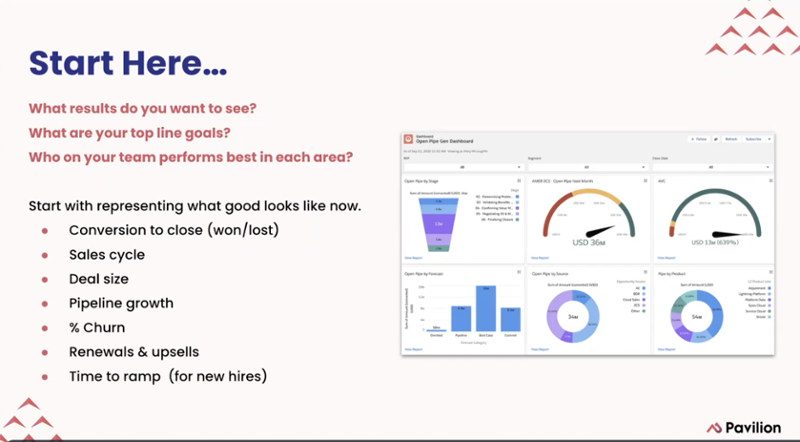The Pavilion community offers many great courses through their PavilionU (Pavilion University) program. Previously, all the courses were live, but recently they also began to offer on-demand, self-paced classes.
"Creating and Implementing a Sales Playbook that Sticks" from Taylor Davis, Sales Strategy Consultant (Skaled Consulting, TPD Consulting), is one of the valuable courses I took last year that is now available on-demand to Pavilion members. Sales playbooks are one of the most useful types of documentation but sadly, they are not as common, as adopted, or as effective as they could be if more people use the helpful learnings in this class to drive their success.
(If you're not a Pavilion member, I have a referral link here if you'd like to check it out. I do earn a commission from any purchases using this link. You can see pricing here.)
Topics in this blog:
-
Session 1: Building a Great Sales Playbook
- Session 2: Making your Playbook Stick
- Session 3: Recession Proofing Your Playbook
Note that there is a lot more advice in the class sessions than the few key points I've highlighted below!
Session 1: Building a Great Sales Playbook
Why, What & How
Agenda:
- Why playbooks
- When to develop
- How to build
- What will make them effective
- Who needs to be involved
- Key takeaways and next steps
Playbooks guide parameters for the science of sales. Think of playbooks as helping teams find and express their own special sauce in sales.
Playbooks help you define processes, get everyone on the same page with the plan, and establish consistency in performance. Taylor has decreased sales cycles by 30-50% just by implementing playbooks.
BUT – playbooks do not achieve these benefits by themselves, just by existing.
You can build the best playbook ever, but if it is not aligned for impact, it will fail.
The #1 reason playbooks fail is because no one has been taught how to use them.
Not many trainings exist inside companies or online (until now!).
How do you prove the playbooks are successful and then get even more people bought into using them?
- By measuring results.
- Though 54% of salespeople who use playbooks are more likely to accomplish their target, and leading sales organizations attribute 60% or more of their total pipeline to deployed sales play, 40% of B2B sales teams don’t have a playbook. :(
- If you have a “lone wolf” on the team who resists process, Taylor said he is that guy, so his advice is to give them room and help them understand the benefits of a playbook. Getting that person involved in developing the playbook is a great way to ensure they use it.
When should you develop a playbook?
Consider these 5 pillars:
- Timing (when)
- Examples: product/service launch or onboarding/hiring
- Expectations (why)
- Examples: increase conversions, decrease sales cycles, increase team retention
- Find your direction (who and how)
- Who is it for, when and how will it be used, how will impact be measured…
- Align with objectives
- Examples: Inbound/outbound, growth stage, teams
- Put content in – pack only what you need
- Think of it like a backpack. Don’t carry a bunch of dead weight. Only pack what you need to be successful.
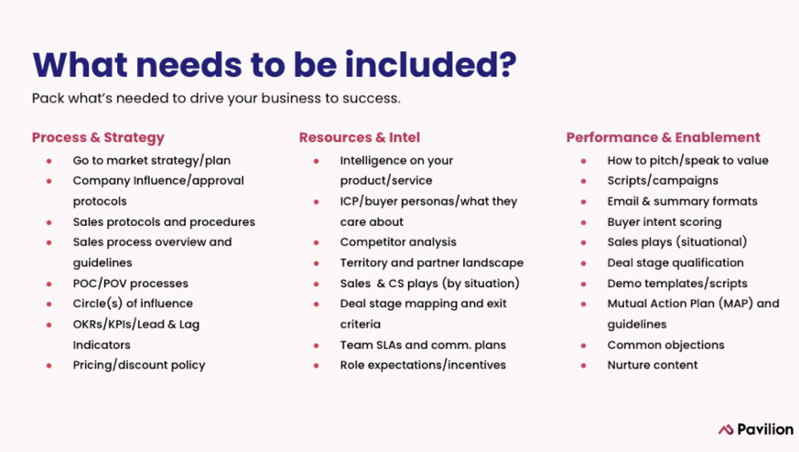
Aligning stakeholders
- Though you need senior leadership buy-in and alignment with the business goals related to playbooks, you also need buy-in from the teams using the playbooks.
- Don’t think of getting alignment or buy-in as groveling or approval. Think of it as explaining what we’re doing, why, and here’s what you’ll get in return.
- Don’t assume that everyone, even leaders, knows the true purpose and benefits of a playbook. Remember that they may have had bad experiences with failed playbook initiatives in the past. You’ll have to do re-education and make them believe in it.
- Map out your circle of influence. Get everyone’s voice included in the playbooks.
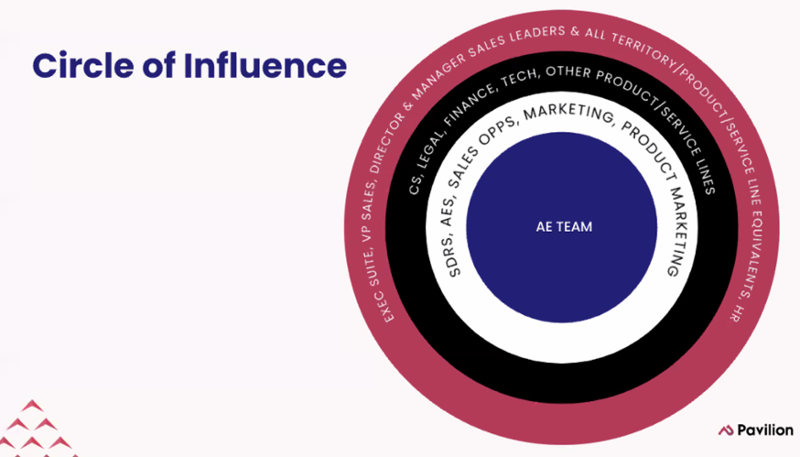
A few more takeaways:
- Playbooks are living documents. They need to be updated to be useful.
- Don’t forget to make playbooks for managers. Everyone can benefit from documentation!!
- If this all seems overwhelming, remember that it’s OK to start small! Start with what is needed, involve your team in building the playbook, and optimize it ongoing.
- Scaling is not a practical expectation until you’ve been able to produce repeatable results. You need to establish some level of consistency first.
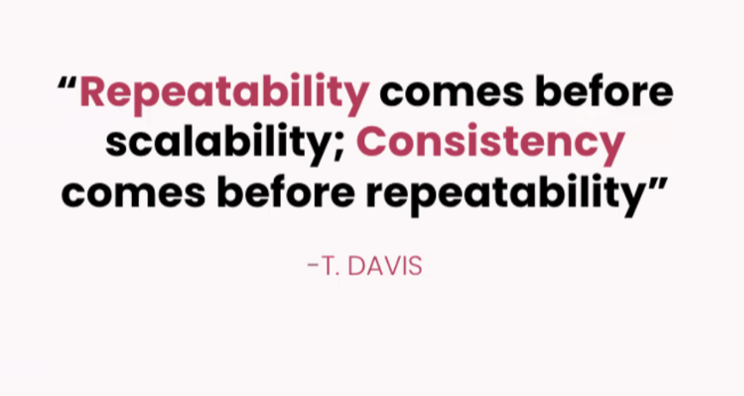
Session 2:
Making your Playbook Stick
Rollout Plans, Team Adoption, and Tracking Effectiveness
Agenda:
- Why Playbooks Fail
- Setup for Success
- Delivering Customer Value
- Metrics and Results
- Managing Stakeholder Expectations
- Prioritizing Team Needs
- Designing for Usability
- Integrating Your Day-To-Day
6 tips to make playbooks stick
- Focus on delivering customer value
- Align with metrics early and often
- Manage stakeholder expectations
- Prioritize deliverables by team needs
- Make it easy to use
- Integrate it into your day-to-day routine
Design for usability
- Keep it short and sweet
- Focus on the most actionable information
- Diversify formats for your team
- Don’t build in a vacuum
- Find ways to make it accessible and memorable
- Keep it clean
Tips for Driving Adoption
- Get scientific - measure how new strategies impact every individual component and then iterate
- Start small. Build out content as strategies and products evolve
- Make your content and trainings snack size and frequent
- Peer-to-peer shared learning is what good looks like
A few more takeaways:
- Playbooks are not a miracle drug, but they drive micro improvements that can save your business.
- Sales team leaders need to take ownership of playbooks and set an example of using them, such as bringing them to meetings and referring to them. Remember that salespeople don’t know how to use this info, because they haven’t been taught. So feed them materials and pitch tips at the right time in the right format.
- Create playbooks to help with what people are struggling with. That will make the team feel good about themselves and about using the playbook, if they see improvements and see the playbook is helping them win.
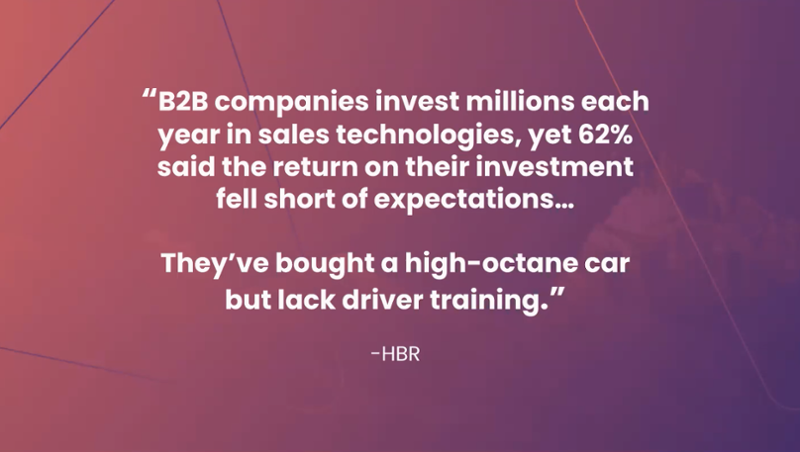
Session 3: Recession-Proofing Your Playbooks
Agenda
- Addressing market shift
- Feedback loops
- Driving change
- Process & Strategy
- People
- Technology
- Content
- Upmarket vs. Downmarket Scenario
- Pivots
- Enablement Tips
This playbook is like a roadmap to a premium buying experience, which happens when you surface the actionable information to bring marketing, sales, and customer success into lockstep and work together with feedback loops instead of working separately in silos.
Addressing market shift
Similar to watching weather changes, where there is some forewarning of storms or tornados, watch for those weather patterns across your business.
Watch for patterns in data and see if buyer intent or another key piece of information inside or outside the business is changing. Then make informed decisions about where and when to change the playbook.
Feedback loops are important for change management and for achieving objectives.
Taylor keeps a running list of questions and includes all go-to-market team leads in reviewing and refreshing the questions and answers often, in order to get all teams in sync. Getting multiple viewpoints helps you identify market shifts earlier.
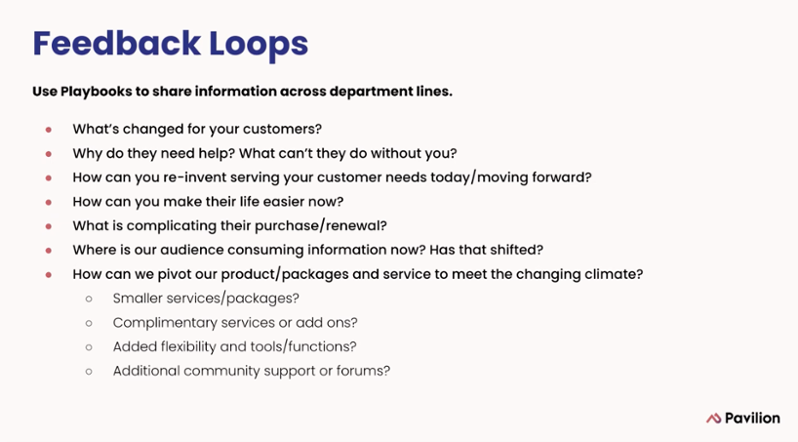
Change management
One big piece most people miss when looking at change: people.
Changing the behavior of people is the hardest thing to do.
Learn how to drive it by speaking to people’s feelings.
Even in organizations that have a focus on data, if you want to motivate someone to change, data alone won’t change behavior. Find a way to help others see the problems and solutions and influence emotion, not just influencing thought.
Analytical arguments are like throwing a fire extinguisher to someone who is drowning. The solution doesn’t match the problem.
Analytical arguments work in other cases. If parameters are known, then assumptions change, when the future is not fuzzy. But if the future is fuzzy, you need to drive emotion and peer-to-peer sharing. You need teams and customers to feel it in order to change behavior in buying and selling.
Get them to see where we can be in the future, to see the goal.
Get them to feel it is possible, that they can do it, and have everyone rally behind the strategy.
Then you can focus on getting them to change, once you get them to feel something emotionally behind it.
Coaching
Don’t stop coaching, whether you're in an up market or down market.
Coach on relationship building, what to do or say that makes the other person feel heard and cherished.
One skill in particular you might coach is copywriting. Copywriting is the #1 skill he sees sales teams lack, writing good follow-up emails, for example. Make sure the content is for and about customers, not about you, the salesperson, or your company. Share how your most-adopted customers are using your solution. Show them how to serve customers better. The #1 thing Taylor has coached on recently is how personalization is being used, because it takes research and sincere engagement.
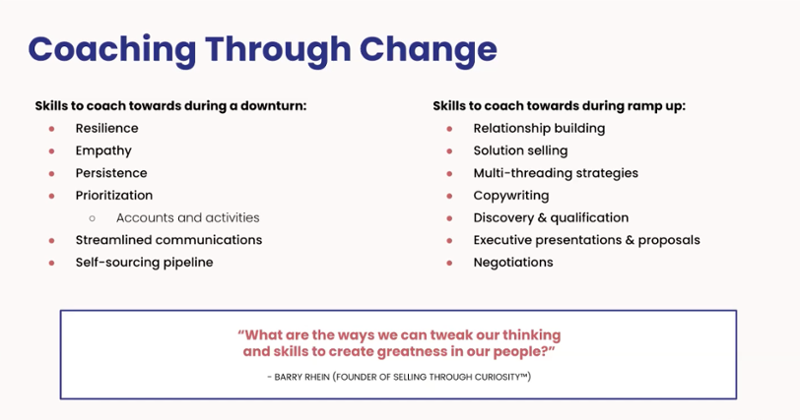
Thank you to Taylor and to Pavilion for this great course! If you're a Pavilion member, you can find more info and enroll in the playbooks course here.
(If you're not a Pavilion member, I have a referral link here if you'd like to check it out. I do earn a commission from any purchases using this link. You can see pricing here)
Topics: Documentation, Education


